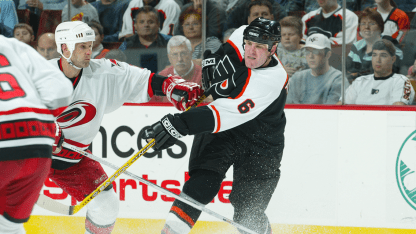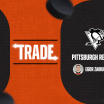Due to the rise in skill of the average NHL player, one of the things that has changed the most in hockey over the years has been teams' approach to the power play. It has changed in terms of the structure of breakouts, the wheel in the neutral zone, entry strategies into the offensive zone and the structure once set up in the neutral zone.
Therien's Take: Grease is the Word
Due to the rise in skill of the average NHL player, one of the things that has changed the most in hockey over the years has been teams' approach to the power play.

By
Chris Therien @ctherien6 / philadelphiaflyers.com
I have seen a lot of different power play setups over the years, first as a player and later as a broadcast analyst and youth hockey coach. I can't say there's one single "best" approach to the power play, but I can speak to my own experiences.
As a defenseman who was a regular part of the penalty kill in the NHL, effective penalty killing started with keeping the power play team working along the perimeter when they had possession of the puck. In fact, any time a play was designed from along the half boards, I always felt it was an advantage to the defensemen and to the penalty killing box in general.
Why? When a player has a park at the half boards, it is true that he's able to assess a lot more options, look around and then attempt to make a play. Do not forget, however, that the penalty killers can do the same thing. The PK can assess the most dangerous option(s), take those away, and force the half-wall quarterback to make either the riskiest play or at least the one with the least chance of ending up in the net.
Some power play setup men are still able to execute the play they want from the half boards. Flyers captain Claude Giroux has put up huge career power play numbers this way, for example. Ditto Washington's Nicklas Backstrom.
In most cases, though, it's "Advantage Team PK" when facing this setup. For example, let's assume the Flyers are playing Washington. Every team in the NHL knows Backstrom much prefers to pass than to shoot, and his options, in order of preference are as follows:
Plan A: Find a seam and pass across the ice for an Alex Ovechkin one-timer attempt from the left circle.
Plan B: Pass back to John Carlson at the point, wherein Carlson will either fire a puck at the net or try to rotate it Ovechkin, depending on what's open.
Plan C: Funnel the puck either to netfront or whoever is in the bumper (slot shooter) role.
Last resort: Shoot the puck himself.
Prescouts are a way of life in the NHL. All teams due their due diligence before the game and they will look at tape -- lots of it, sometimes -- to discern exactly what the other team will do. Washington's power play is one of the most predictable you'll ever see, yet good luck stopping them. They just execute so well, most of the time as long as there is a lane open -- or a lane created.
Speaking generically, with a half boards setup, other players have to move around and they have to read off the focal point (the guy with the puck). Most of the time, as long as the PK is in synch, these usually generated low quality chances in my experiences on the ice.
My job was to battle in front and to help block out those lanes. When our PK collectively sealed off the lanes, we had a better chance of killing the penalty. That was especially with the help of a goaltender who was willing to help eliminate the cross-crease pass.
Most of the time, the only thing open was a bad-angle shot or a clear-sighted one that the goalie would handle routinely. Other common results: Forced passes that never got through the box and were easy to break up, or wild shots that would either miss the net or rim out sharply around the wall. In effect, the power play team was killing time off the penalty for us. They'd have to regroup and start from scratch.
What kind of power play did I NOT like as a penalty killer? It's probably not what you'd think, because the strategy gets a bad rep nowadays: I found it tougher to defend against power plays that focused on moving the puck back to a trigger man at the point with layers of screens and deflection candidates in front.
When the puck goes out to a point man, who is able to take a step to the middle of the ice -- not from near where the blueline meets the wall -- it is far and away the most difficult, and chaotic scenario for the PK and the goalie.
First of all, there's always the initial chance that the point man will score through traffic or someone (including possibly one of the PKers) will cause the puck to change direction on the goalie. While only a small percentage of these shots go in the net, the chances of a goal go up considerably if there's a rebound in the slot or a carom to another attacker; both of which are unpredictable for the PK and, as such, hard to prevent. Chaos ensues if the point man's shot isn't blocked or fired wildly off target. You just hope your goalie gets it cleanly.
It's one of those heat of battle situations that's hard to describe as you frenetically try to find a loose puck. It truly becomes a 50-50 situation, and sometimes not even that good of odds for the defender. The reason: the attacker is facing the puck as it comes out. You, as the defenseman, are initially facing the attacker. Advantage: Team Power Play.
Lots of power plays, especially nowadays, rely on trying to put a pass across the ice. Yes, if there's a breakdown by the PK -- an overload, a bad gap, a stick or body not in the correct lane -- it can produce a very dangerous scoring chance that requires the goalie to make a miraculous save or the shooter to make a mistake.
Far more often, though, it results in a whole lot of holding the puck for too long, a bobble, a turnover on a forced pass (sometimes presenting a shorthanded breakaway or 2-on-1), or a low-percentage shot.
Nowadays, all power plays start with an offensive zone draw for the power play team. I would love to see the average numbers for power play success rates when the initial draw is lost rather than won (which means instant control and set-up opportunity). The majority of PKs today are pretty good at disrupting or breaking up entries.
It's just a theory but I think a big part of the reason why power play percentages on the whole are a bit higher on average nowadays starts with the ability to start every power play in the offensive zone -- and, nowadays, to choose the circle in which the first faceoff is dropped.There can be a bit of chaos in its own right off the draw. Since PK work is as much about structure and rhythm as a power play being in synch, chaotic situations create attacking opportunities for skill power play personnel.
I like watching tic-tac-toe tap-in goals and scorching one-timer goals as much as the next person. Skilled goals off the rush are always a treat, too, at least when your team is on the scoring end. However, these surgical-strike plays are hard to rely on at the NHL level. That's something that Flyers rookie center Morgan Frost, who set up bushels of such goals in junior hockey, is learning firsthand this year in the NHL and AHL. He's still learning how most pro-level power play goals get scored.
Quick puck movement, and pucks to the net with traffic in front may not look as pretty. The goals that are scored that way are, in fact, usually pretty "greasy" and require volume as opposed to singular setups. But watch the power play goals that will be scored this spring in the playoffs, when PKs are especially locked in on taking away the middle. The chaotic goals on loose pucks, deflections and screens will rule the roost. They usually do.
You might say, "Grease is the word" the further and further you get into the spring.


















